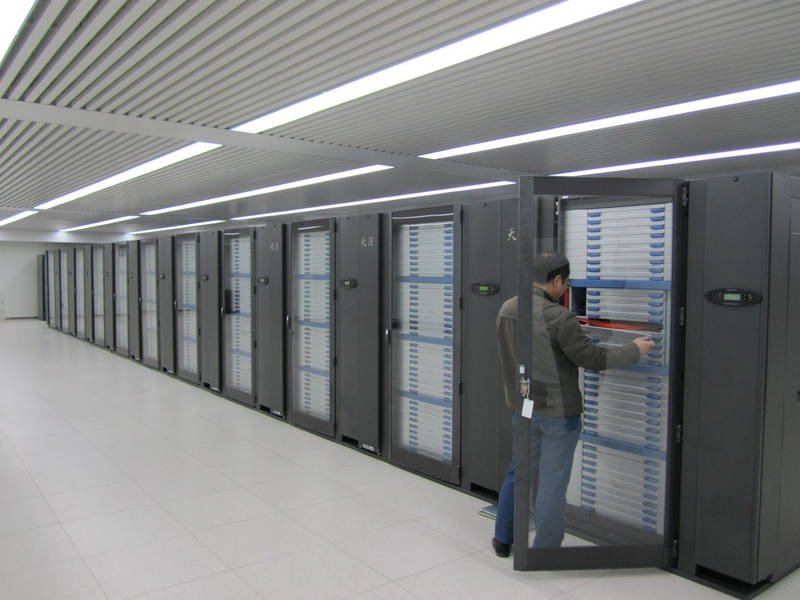China Beats US On Fastest Supercomputers List
China has once again prevailed in the biannual list of the world's fastest supercomputers. The country not only claimed the top two fastest supercomputer systems, it beat the United States in the overall number of systems ranked.
The Top500 report that ranks the world's speediest super machines sees China's Sunway TaihuLight maintain its lead at the top of the list for the fourth time; it boasts a performance of 93.01 petaflops. China's Tianhe-2, also known as the Milky Way-2, remains at the number two spot with three times less the performance at 33.86 petaflops.
Tianhe-2 was crowned the fastest system for three years until it was replaced by TaihuLight in November 2015. The former was built using 16,000 computer nodes, each including two Intel Ivy Bridge Xeon processors and three Xeon Phi coprocessor chips, whereas the latter is composed entirely of processors made and designed in China; specifically, it’s composed of 40,960 Chinese-designed SW26010 manycore 64-bit RISC processors that are formed on the Sunway architecture.
Ironically, the Sunway TaihuLight most likely achieved its position because of the U.S. Back in 2015, the U.S. government barred Intel from helping China update the Tianhe-2 computer. The chip maker had applied for a license that would allow it to export tens of thousands of processors required to improve the supercomputer. The Department of Commerce rejected the application, citing concerns regarding nuclear research being carried out by the machine.
Following the aforementioned systems, in the No. 3 spot is Switzerland's Piz Daint, a supercomputer that has the accolade of being the most powerful supercomputer in Europe. A newcomer to the rankings is a system from Japan named Gyoukou, which takes 4th, consequently displacing Titan, America's top system, to the No. 5 position.
Coming in at sixth in the rankings is Sequoia, an IBM BlueGene/Q system installed at DOE’s Lawrence Livermore National Laboratory, which features 17.17 petaflops. The list's new number seven is a system called Trinity, a Cray XC40 supercomputer operated by Los Alamos National Laboratory and Sandia National Laboratories, with 14.14 petaflops.
Cori, a Cray XC40 supercomputer, is found at the National Energy Research Scientific Computing Center (NERSC) and lands eighth place with 14.01 petaflops. Oakforest-PACS, a Fujitsu PRIMERGY CX1640 M1 is installed at Joint Center for Advanced High Performance Computing in Japan, and places ninth at 13.55 petaflops. Rounding off the list of the top ten is Japan's Fujitsu’s K computer with 10.51 petaflops.
Get Tom's Hardware's best news and in-depth reviews, straight to your inbox.
The 50th edition of Top500 also reveals that China has overtaken the United States in the total number of ranked systems by 202 to 144. A mere six months ago, the United States lead with 169 systems to China's 160. Both are far ahead of the rest of the pack. Japan has the third most with a total of 35 systems, while Germany has 20, followed by France with 18, and the UK with 15.
As for performance metrics, Top500 noted: "For the first time, each of the top 10 supercomputers delivered more than 10 petaflops on HPL. There are also 181 systems with performance greater than a petaflop – up from 138 on the June 2017 list. Taking a broader look, the combined performance of all 500 systems has grown to 845 petaflops, compared to 749 petaflops six months ago and 672 petaflops one year ago.”
However, the report also noted that “Even though aggregate performance grew by nearly 100 petaflops, the relative increase is well below the list’s long-term historical trend." In other words, there’s still growth, but that growth isn’t as dramatic year-over-year as it has been.
China's advancement in supercomputers has also seen the country overtake the United States in aggregate performance. The former now claims 35.4% of the Top500 flops followed by the U.S. in second place with 29.6%.

Zak Islam is a freelance writer focusing on security, networking, and general computing. His work also appears at Digital Trends and Tom's Guide.
-
beecham.james.d It's not "three times less the performance", that would place it deep in the negative. It's "at approximately 1 third the performance" or "with 2/3rds less performance". If you gained $100,000 last year and gained 300% (3x) less this ear, you would have gained a $300,000 debt.Reply -
anbello262 Actually, it would be correct to say "three times less the performance", it is not wrong. The English language is quite ambiguous, so it could have both meanings (1/3 or -3), but since one of the meanins doesn't make sense, the correct one is the only one left.Reply
I will agree that it would be "better" to say 1/3rd, but it is not "incorrect". -
alextheblue Reply
Real-time dystopian facial recognition, ID scanning, and tracking of all their citizens.20374977 said:okay, so what are they actually doing with it? -
stewartlands No. It is not correct to say 'three times less" when comparing two things if one really means "one-third." For example, when comparing the number two to the number six, two is four less than six and three times that is twelve. So, how is two three times less than six?Reply -
garyisabusyguy What I find impressive is that they took the open-sourced plans of the DEC ALPHA chips, that were killed by HP and Intel, and turned them into something that runs rings around our x86 garbage.Reply
I love it when a socialist (small S intentional) Technocracy demonstrates that free-market-capitalism isn't the only game in town. -
trulydetestable1 simulation of everything material to simulate the condition in use. jet engine parts. robotic in harsh condition. explosives in underground bunkers. how to make dumpling on the moon base.Reply -
ZolaIII Reply20374977 said:okay, so what are they actually doing with it?
Calculating US debt (to them) with interest ahead of time. -
beecham.james.d @ANBELLO262 - I suggest you read "Common errors in English usage", as you are flat-our wrong. ISBN-13: 978-1590282076 or ISBN-10: 1590282078Reply
